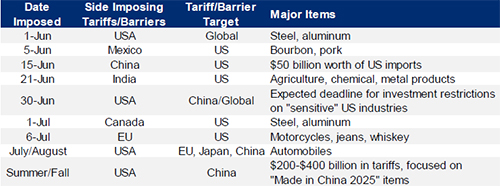August 2018
Trump favoured son on economic management
By Simson Sanaphay
Who Cares about Trade Wars?
Tariff brinkmanship has buffeted markets this year but the recent rally that followed an apparent truce between US President Donald Trump and Europe in early August was quickly overshadowed by threats the US will raise tariffs from 10 per cent to 25 per cent on USD200bn of Chinese goods.
Citi analysts expect the move would drag 83 basis points from China’s economic growth and reduce China’s exports to the US by USD101.7bn.
The US stance was widely reported as a tactic to drag China back to the negotiating table to tackle the bilateral trade deficit – the US posted a USD376bn deficit of goods with China in 2017 – and to get tighter measures to counter reported intellectual property theft by Chinese firms, a long time thorn in US-Chinese trade relations.
China has acknowledged it has a lot of work to do to safeguard foreign firms' international property rights, but it has also stated through its official news agencies that China is prepared for a protracted trade war.
Given China’s economy is slowing, combined with its need to continue to grow its middle class base to progress its aim for a self-feeding consumer market, it’s debateable just how much pain China is willing to suffer in a trade war with a strengthening US economy.
Trump on the other hand has significant support for his trade tactics from the American people. A CNBC poll in June found 54 per cent of Americans approve of his handling of the economy. Another poll run at the same time by Politico Magazine found 35 per cent thought the initial steel and aluminium tariffs announced at that time would benefit the US economy while another 20 per cent had no opinion. Clearly, the “America First” rhetoric Trump has trumpeted resonates with a significant portion of the population.
The Art of Trade Tensions – Attack and Counter-attack

However, the fallout is palatable in global markets, and we disagree with some economists who appear to treat tariff impact as a mere “sentiment” issue for financial markets. Tariffs are material for the corporate profit outlook. They will mean lost business for some firms, without giving them cost relief.
To pursue this thread it is important to understand that US firms are heavily represented in Chinese supply chains and there is a high positive correlation between S&P 500 EPS growth and US Trade Growth. The message is a negative impact on trade will reverberate across earnings guidance.
Certainly that’s not the case yet. With more than 60 per cent of the companies in S&P 500 already reporting Q2 earnings, 86 per cent passed earnings expectations and nearly 75 per cent beat revenue expectations. But as an ongoing issue if it does impact earnings guidance it’s interesting to consider how far President Trump would pursue a trade policy that would dampen the impact of his administration’s corporate tax reform platform. We also expect continued pushback on trade tensions from financial markets, US stakeholders and continued pressure for a ‘deal’.
And there are measures being pursued. A bipartisan House bill has already been introduced to give Congress a 60-day period to review trade restriction proposals. The bill would be retrospective two years from the enactment date. Similarly, the US Senate backed a non-binding motion to give Congress a role when the President decides to impose tariffs on national security grounds.
Trade policy and the uncertainty that it brings has at least in the short term continued to dominate investor concerns and at the same time eroded conviction in the fundamental drivers of economic and market performance which have been constructive so far in 2018.
The implementation of increased tariffs is a material risk and it may require evidence of further financial or economic damage in the US to stave off even more drastic trade restrictions.
We are on guard for spillover into the real economy that harms investments and hiring and consumption decisions that have been critical for above-trend global growth in the US this year.
Given that trade tensions are likely to drive continued market volatility, it is even more important for investors to adopt a diversified multi-asset class portfolio approach to benefit from rising equity markets and low volatility/low correlation investments to help offset downside risks.
Specifically, we see investment grade corporate bonds as an important “risk dampener” within portfolios. Yields are attractive and this asset class benefits from a lower level of correlation relative to equities while generating reliability in income.
Nonetheless it remains vitally important that investors are not impulsively making investment decisions for income or growth by reacting to only the day’s concerns.
Being driven by volatility can both decrease opportunities and create a poor decision making process. Panicked investors are more likely to hold cash, which has been the worst performing asset class this decade.
Disclaimer: This document has been prepared for general information purposes only. Any advice contained in this document has been prepared without taking into account your objectives, financial situation or needs. Before acting on any advice in this document, Citi recommends that you consider if it's appropriate for your particular circumstances. Investors are advised to obtain independent legal, financial, and taxation advice prior to investing.
All opinions and estimates constitute Citigroup Pty Limited AFSL No: 238098 ("CIti") judgement as of the date of this report and are subject to change without notice.













